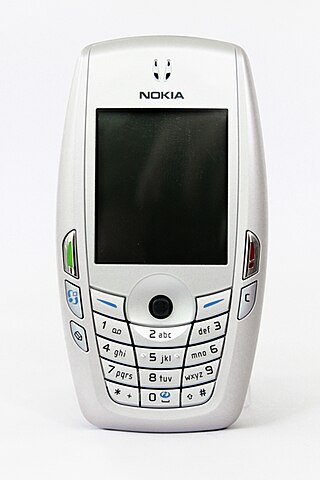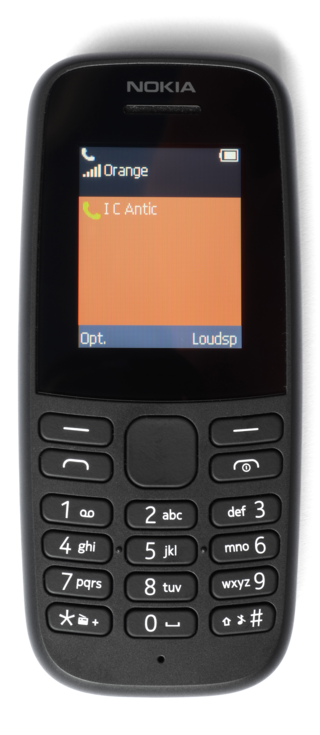
The S60 Platform was a software platform for smartphones that runs on top of the Symbian operating system. It was created by Nokia based on the 'Pearl' user interface from Symbian Ltd. It was introduced at COMDEX in November 2001 and first shipped with the Nokia 7650 smartphone. The platform has since seen 5 updated editions. Series 60 was renamed to S60 in November 2005.

UIQ was a software platform based upon Symbian OS, created by UIQ Technology AB. It is a graphical user interface layer that provides additional components to the core operating system, to enable the development of feature-rich mobile phones that are open to expanded capabilities through third-party applications.

The 6620 is a mobile phone created by Nokia, announced in 2005, running on Series 60 2nd Edition and the Symbian operating system. It was the first EDGE-capable phone for the Americas' market.

Nokia 9500 Communicator is a mobile phone produced by Nokia, introduced on 24 February 2004 and released in November 2004. It runs on the Symbian-based Series 80 platform.

The Nokia 7610 is a Symbian OS mobile phone introduced at CEBIT on 18 March 2004. It features a 1 megapixel camera with a design similar to 2003's Nokia 7600. It went on sale with a list price of €500 and came with a 64 MB MMC card. It runs on Nokia's Series 60 platform. It was marketed as a stylish and imaging device, and allowed direct Bluetooth photo printing. End-users can also use the 7610 with Nokia Lifeblog. Other pre-installed applications include the Opera Mobile web browser, RealPlayer and Kodak Photo Sharing.

The Nokia 6600 is a mobile phone introduced on 16 June 2003 by Nokia, costing approximately €600 when released in October 2003. It was Nokia's high-end model of the 6xxx Classic Business Series. At the time of release, it was the most advanced product ever launched by Nokia, and it runs on Symbian OS 7.0s. It also featured a VGA camera, a music player and video player, Bluetooth and extended storage by memory card, being the second non-Communicator to do so.

The Nokia 6680 is a high-end 3G mobile phone running Symbian operating system, with Series 60 2nd Edition user interface. It was announced on 14 February 2005, and was released the next month. The 6680 was Nokia's first device with a front camera, and was specifically marketed for video calling. It was also Nokia's first with a camera flash. It was the forerunner of the Nseries, which was released in April 2005; its successor being the N70.
Visual radio is a generic term for adding visuals to audio radio broadcasts. Visual Radio is also a trademark for a Nokia product which delivers interactive FM radio over a data connection.
Series 40, often shortened as S40, is a software platform and application user interface (UI) software on Nokia's broad range of mid-tier feature phones, as well as on some of the Vertu line of luxury phones. It was one of the world's most widely used mobile phone platforms and found in hundreds of millions of devices. Nokia announced on 25 January 2012 that the company has sold over 1.5 billion Series 40 devices. It was not used for smartphones, with Nokia turning first to Symbian, then in 2012–2017 to Windows Phone, and most recently Android. However, in 2012 and 2013, several Series 40 phones from the Asha line, such as the 308, 309 and 311, were advertised as "smartphones" although they do not actually support smartphone features like multitasking or a fully fledged HTML browser.
Nokia Lifeblog is a discontinued multimedia diary and website administration tool that automatically collects all the photos, videos, and sound clips that the user creates on the mobile phone, text messages and MMS messages that were sent and received. It also allows the user to create text and audio notes. It organizes all the contents in a Timeline and renders the diary searchable via its contents and via automatically and manually created metadata, including time, location, tags, descriptions, filenames, sender and recipient information.

Windows Phone (WP) is a discontinued mobile operating system developed by Microsoft for smartphones as the replacement successor to Windows Mobile and Zune. Windows Phone featured a new user interface derived from the Metro design language. Unlike Windows Mobile, it was primarily aimed at the consumer market rather than the enterprise market.

The Nokia 6280 Series, is a series of slider type phones first released in Q4, 2005.
A Mobile Web Server is software designed for modern-day smartphones to host personal web servers through the use of open sourced software.

The Series 30, often shortened as S30, is a software platform and application user interface created by Nokia for its entry level mobile phones, lower than Series 40. S30 phones are not capable of running Java apps. In 2014, Microsoft acquired Nokia's mobile phones business and later used S30 in along of Series 30+.

Symbian is a discontinued mobile operating system (OS) and computing platform designed for smartphones. It was originally developed as a proprietary software OS for personal digital assistants in 1998 by the Symbian Ltd. consortium. Symbian OS is a descendant of Psion's EPOC, and was released exclusively on ARM processors, although an unreleased x86 port existed. Symbian was used by many major mobile phone brands, like Samsung, Motorola, Sony Ericsson, and above all by Nokia. It was also prevalent in Japan by brands including Fujitsu, Sharp and Mitsubishi. As a pioneer that established the smartphone industry, it was the most popular smartphone OS on a worldwide average until the end of 2010, at a time when smartphones were in limited use, when it was overtaken by iOS and Android. It was notably less popular in North America.
Microsoft mobile services are a set of proprietary mobile services created specifically for mobile devices, they are typically offered through mobile applications and mobile browser for Windows Phone platforms, BREW, and Java. Microsoft's mobile services are typically connected with a Microsoft account and often come preinstalled on Microsoft's own mobile operating systems while they are offered via various means for other platforms. Microsoft started to develop for mobile computing platforms with the launch of Windows CE in 1996 and later added Microsoft's Pocket Office suite to their Handheld PC line of PDAs in April 2000. From December 2014 to June 2015, Microsoft made a number of corporate acquisitions, buying several of the top applications listed in Google Play and the App Store including Acompli, Sunrise Calendar, Datazen, Wunderlist, Echo Notification Lockscreen, and MileIQ.

Series 30+ is a software platform and application user interface used for Nokia-branded mobile devices. The platform was introduced by Nokia in September 2013, first appearing on the Nokia 108, and has been the main Nokia feature phone operating system after the end of the Series 30 and Series 40 platforms in 2014. Despite the similar name and user interface, S30+ is technically completely different and unrelated to S30.

Here WeGo is a web mapping and satellite navigation software, operated by HERE Technologies and available on the Web and mobile platforms. It is based on HERE's location data platform, providing its in-house data, which includes satellite views, traffic data, and other location services. Maps are updated every two or three months.













